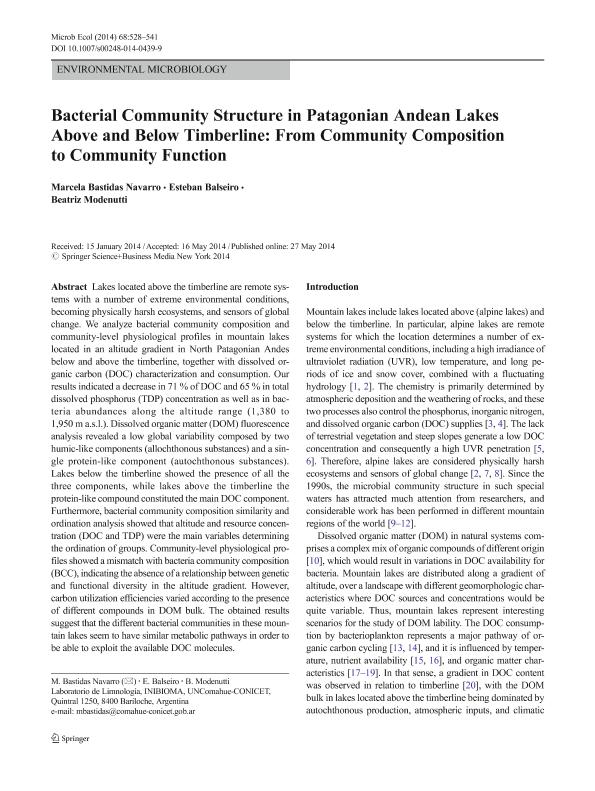Mostrar el registro sencillo del ítem
dc.contributor.author
Bastidas Navarro, Marcela Alejandra

dc.contributor.author
Balseiro, Esteban Gabriel

dc.contributor.author
Modenutti, Beatriz Estela

dc.date.available
2017-01-26T21:02:57Z
dc.date.issued
2014-10
dc.identifier.citation
Bastidas Navarro, Marcela Alejandra; Balseiro, Esteban Gabriel; Modenutti, Beatriz Estela; Bacterial community structure in Patagonian Andean lakes above and below timberline: from community composition to community function; Springer; Microbial Ecology; 68; 3; 10-2014; 528-541
dc.identifier.issn
0095-3628
dc.identifier.uri
http://hdl.handle.net/11336/12055
dc.description.abstract
Lakes located above the timberline are remote systems with a number of extreme environmental conditions, becoming physically harsh ecosystems, and sensors of global change. We analyze bacterial community composition and community-level physiological profiles in mountain lakes located in an altitude gradient in North Patagonian Andes below and above the timberline, together with dissolved organic carbon (DOC) characterization and consumption. Our results indicated a decrease in 71 % of DOC and 65 % in total dissolved phosphorus (TDP) concentration as well as in bacteria abundances along the altitude range (1,380 to 1,950 m a.s.l.). Dissolved organic matter (DOM) fluorescence analysis revealed a low global variability composed by two humic-like components (allochthonous substances) and a single protein-like component (autochthonous substances). Lakes below the timberline showed the presence of all the three components, while lakes above the timberline the protein-like compound constituted the main DOC component. Furthermore, bacterial community composition similarity and ordination analysis showed that altitude and resource concentration (DOC and TDP) were the main variables determining the ordination of groups. Community-level physiological profiles showed a mismatch with bacteria community composition (BCC), indicating the absence of a relationship between genetic and functional diversity in the altitude gradient. However, carbon utilization efficiencies varied according to the presence of different compounds in DOM bulk. The obtained results suggest that the different bacterial communities in these mountain lakes seem to have similar metabolic pathways in order to be able to exploit the available DOC molecules.
dc.format
application/pdf
dc.language.iso
eng
dc.publisher
Springer

dc.rights
info:eu-repo/semantics/openAccess
dc.rights.uri
https://creativecommons.org/licenses/by-nc-sa/2.5/ar/
dc.subject
Mountain Patagonian Andean Lakes
dc.subject
Taxonomic Diversity
dc.subject
Functional Diversity
dc.subject
Altitudinal Gradient
dc.subject.classification
Ecología

dc.subject.classification
Ciencias Biológicas

dc.subject.classification
CIENCIAS NATURALES Y EXACTAS

dc.title
Bacterial community structure in Patagonian Andean lakes above and below timberline: from community composition to community function
dc.type
info:eu-repo/semantics/article
dc.type
info:ar-repo/semantics/artículo
dc.type
info:eu-repo/semantics/publishedVersion
dc.date.updated
2016-12-12T14:23:39Z
dc.identifier.eissn
1432-184X
dc.journal.volume
68
dc.journal.number
3
dc.journal.pagination
528-541
dc.journal.pais
Estados Unidos

dc.journal.ciudad
Nueva York
dc.description.fil
Fil: Bastidas Navarro, Marcela Alejandra. Consejo Nacional de Investigaciones Científicas y Técnicas. Centro Científico Tecnológico Patagonia Norte. Instituto de Investigación en Biodiversidad y Medioambiente; Argentina. Universidad de Buenos Aires. Facultad de Ciencias Exactas y Naturales. Departamento de Ecología, Genética y Evolución. Laboratorio de Limnología; Argentina
dc.description.fil
Fil: Balseiro, Esteban Gabriel. Consejo Nacional de Investigaciones Científicas y Técnicas. Centro Científico Tecnológico Patagonia Norte. Instituto de Investigación en Biodiversidad y Medioambiente; Argentina. Universidad Nacional del Comahue. Centro Regional Universitario Bariloche. Laboratorio de Limnologia; Argentina
dc.description.fil
Fil: Modenutti, Beatriz Estela. Universidad Nacional del Comahue. Centro Regional Universitario Bariloche. Laboratorio de Limnologia; Argentina. Consejo Nacional de Investigaciones Científicas y Técnicas. Centro Científico Tecnológico Patagonia Norte. Instituto de Investigación en Biodiversidad y Medioambiente; Argentina
dc.journal.title
Microbial Ecology

dc.relation.alternativeid
info:eu-repo/semantics/altIdentifier/doi/http://dx.doi.org/10.1007/s00248-014-0439-9
dc.relation.alternativeid
info:eu-repo/semantics/altIdentifier/url/http://link.springer.com/article/10.1007%2Fs00248-014-0439-9
Archivos asociados
